Land Suitability and Insurance Premiums: A GIS-based Multicriteria Analysis Approach for Sustainable Rice Production
Abstract
1. Introduction
2. Methodology
2.1. Study Area and Data Collection
2.2. Land Suitability with Multicriteria Analysis
2.2.1. Slope
2.2.2. Elevation
2.3.3. Top Soil Texture
2.2.4. Land Type
2.2.5. Soil pH
2.2.6. Temperature
2.2.7. Rainfall
2.2.8. Flood Prone
2.2.9. Land Use
2.3. Preferences of Criteria in Decision Analysis
2.4. Analytical Hierarchy Process (AHP)
2.5. Weighted Overlay Analysis for Land Suitability
2.6. Crop Insurance
2.6.1. Product Price
2.6.2. Awareness
2.6.3. Belief of the Benefits
2.6.4. Collection and Distribution of Money
2.6.5. Trust in the Company
2.6.6. Rules and Regulations
2.6.7. Willingness of the Government
2.6.8. Government Subsidy
2.7. Insurance Coverage and Premium Rate
3. Results
3.1. Land Suitability
3.2. Insurance Premium and Coverage
4. Discussion
5. Conclusions
Author Contributions
Acknowledgments
Conflicts of Interest
Appendix A. “Land Suitability Analysis for Paddy in Northern Parts of Bangladesh: Introducing Geo-Spatial Insurance Premium” SURVEY
| 1 | Name | |
| 2 | Position and Address |
Appendix A.1. Section-1: Please select scale number of criteria for land suitability mapping of rice production in the northern part of Bangladesh.
| Criteria | Slope | Elevation | Land Type | Top Soil Texture | Soil pH | Flood Prone | Temperature | Rainfall |
| Example | 6 | 5 | 9 | 7 | 7 | 4 | 3 | 3 |
| Your Opinion |
Appendix A.2. Section-2 Please select weight of criteria for land suitability mapping of rice production in the northern part of Bangladesh
| 1: the second equally important criteria | 3: criterion (A) is little more important than (B) |
| 5: criteria (A) is more important than (B) | 7: criterion (A) is much more important than (B) |
| 9: criterion (A) is absolutely more important than (B) | * and that goes for the reverse |
| Criteria A | Scale | Scale | Criteria B | ||||||||||||||||
|---|---|---|---|---|---|---|---|---|---|---|---|---|---|---|---|---|---|---|---|
| 9 | 8 | 7 | 6 | 5 | 4 | 3 | 2 | 1 | 2 | 3 | 4 | 5 | 6 | 7 | 8 | 9 | |||
| 1 | Land Type | ✓ | Top Soil Texture | ||||||||||||||||
| Criteria A | Scale | Scale | Criteria B | ||||||||||||||||
|---|---|---|---|---|---|---|---|---|---|---|---|---|---|---|---|---|---|---|---|
| 9 | 8 | 7 | 6 | 5 | 4 | 3 | 2 | 1 | 2 | 3 | 4 | 5 | 6 | 7 | 8 | 9 | |||
| 1 | Slope | Elevation | |||||||||||||||||
| 2 | Slope | Land Type | |||||||||||||||||
| 3 | Slope | Top Soil Texture | |||||||||||||||||
| 4 | Slope | Soil pH | |||||||||||||||||
| 5 | Slope | Flood Prone | |||||||||||||||||
| 6 | Slope | Temperature | |||||||||||||||||
| 7 | Slope | Rainfall | |||||||||||||||||
| 8 | Elevation | Land Type | |||||||||||||||||
| 9 | Elevation | Top Soil Texture | |||||||||||||||||
| 10 | Elevation | Soil pH | |||||||||||||||||
| 11 | Elevation | Flood Prone | |||||||||||||||||
| 12 | Elevation | Temperature | |||||||||||||||||
| 13 | Elevation | Rainfall | |||||||||||||||||
| 14 | Land Type | Top Soil Texture | |||||||||||||||||
| 15 | Land Type | Soil pH | |||||||||||||||||
| 16 | Land Type | Flood Prone | |||||||||||||||||
| 17 | Land Type | Temperature | |||||||||||||||||
| 18 | Land Type | Rainfall | |||||||||||||||||
| 19 | Top Soil Texture | Soil pH | |||||||||||||||||
| 20 | Top Soil Texture | Flood Prone | |||||||||||||||||
| 21 | Top Soil Texture | Temperature | |||||||||||||||||
| 22 | Top Soil Texture | Rainfall | |||||||||||||||||
| 23 | Soil pH | Flood Prone | |||||||||||||||||
| 24 | Soil pH | Temperature | |||||||||||||||||
| 25 | Soil pH | Rainfall | |||||||||||||||||
| 26 | Flood Prone | Temperature | |||||||||||||||||
| 27 | Flood Prone | Rainfall | |||||||||||||||||
| 28 | Temperature | Rainfall | |||||||||||||||||
Appendix B. “Land Suitability Analysis for Paddy in Northern Parts of Bangladesh: Introducing Geo-Spatial Insurance Premium” SURVEY
| 1 | Name | |
| 2 | Position and Address |
Appendix B.1. Section-1 Please select scale number of criteria for insurance premiums based on land suitability for rice production in the northern part of Bangladesh
| Criteria | Product Price | Awareness | Believe of Benefits | Collection and Distribution of Money | Trust to Company | Rules and Regulations | Willingness of Govt. | Govt. Subsidy |
| Example | 9 | 5 | 6 | 2 | 7 | 4 | 3 | 3 |
| Your Opinion |
Appendix B.2. Section-2 Please fill out with selecting weight of criteria for insurance premiums based on land suitability for rice production in the northern part of Bangladesh
| 1: the second equally important criteria | 3: criterion (A) is little more important than (B) |
| 5: criteria (A) is more important than (B) | 7: criterion (A) is much more important than (B) |
| 9: criterion (A) is absolutely more important than (B) | * and that goes for the reverse |
| Criteria A | Scale | Scale | Criteria B | ||||||||||||||||
|---|---|---|---|---|---|---|---|---|---|---|---|---|---|---|---|---|---|---|---|
| 9 | 8 | 7 | 6 | 5 | 4 | 3 | 2 | 1 | 2 | 3 | 4 | 5 | 6 | 7 | 8 | 9 | |||
| 1 | Product Price | ✓ | Awareness | ||||||||||||||||
| Criteria A | Scale | Scale | Criteria B | ||||||||||||||||
|---|---|---|---|---|---|---|---|---|---|---|---|---|---|---|---|---|---|---|---|
| 9 | 8 | 7 | 6 | 5 | 4 | 3 | 2 | 1 | 2 | 3 | 4 | 5 | 6 | 7 | 8 | 9 | |||
| 1 | Product Price | Awareness | |||||||||||||||||
| 2 | Product Price | Believe of Benefits | |||||||||||||||||
| 3 | Product Price | Collection and Distribution of Money | |||||||||||||||||
| 4 | Product Price | Trust to the Company | |||||||||||||||||
| 5 | Product Price | Rules and Regulations | |||||||||||||||||
| 6 | Product Price | Willingness of Government | |||||||||||||||||
| 7 | Product Price | Govt. Subsidy | |||||||||||||||||
| 8 | Awareness | Believe of Benefits | |||||||||||||||||
| 9 | Awareness | Collection and Distribution of Money | |||||||||||||||||
| 10 | Awareness | Trust to the Company | |||||||||||||||||
| 11 | Awareness | Rules and Regulations | |||||||||||||||||
| 12 | Awareness | Willingness of Government | |||||||||||||||||
| 13 | Awareness | Govt. Subsidy | |||||||||||||||||
| 14 | Believe of Benefits | Collection and Distribution of Money | |||||||||||||||||
| 15 | Believe of Benefits | Trust to the Company | |||||||||||||||||
| 16 | Believe of Benefits | Rules and Regulations | |||||||||||||||||
| 17 | Believe of Benefits | Willingness of Government | |||||||||||||||||
| 18 | Believe of Benefits | Government Subsidy | |||||||||||||||||
| 19 | Collection and Distribution of Money | Trust to the Company | |||||||||||||||||
| 20 | Collection and Distribution of Money | Rules and Regulations | |||||||||||||||||
| 21 | Collection and Distribution of Money | Willingness of Government | |||||||||||||||||
| 22 | Collection and Distribution of Money | Government Subsidy | |||||||||||||||||
| 23 | Trust to the Company | Rules and Regulations | |||||||||||||||||
| 24 | Trust to the Company | Willingness of Government | |||||||||||||||||
| 25 | Trust to the Company | Government Subsidy | |||||||||||||||||
| 26 | Rules and Regulations | Willingness of Government | |||||||||||||||||
| 27 | Rules and Regulations | Government Subsidy | |||||||||||||||||
| 28 | Willingness of Government | Government Subsidy | |||||||||||||||||
References
- Salman, S.M.; Mahul, O.; Bagazonzya, H.K. Agricultural Insurance in Bangladesh Promoting Access to Small and Marginal Farmers; The World Bank: Washington, DC, USA, 2010; p. 146. [Google Scholar]
- Habiba, U.; Shaw, R. Crop Insurance as a Risk Management Strategy in Bangladesh. In Disaster Risk Reduction Approaches in Bangladesh; Springer: Tokyo, Japan, 2009. [Google Scholar]
- Godfray, H.C.J.; Beddington, J.R.; Crute, I.R.; Haddad, L.; Lawrence, D.; Muir, J.F.; Pretty, J.; Robinson, S.; Thomas, S.M.; Toulmin, C. Food security: The challenge of feeding 9 billion people. Science 2010, 327, 812–818. [Google Scholar] [CrossRef] [PubMed]
- Ahmed, A.; Ryosuke, S. Climate Change and Agricultural Food Production of Bangladesh: An Impact Assessment Using GIS-Based Biophysical Crop; Simulation Model; Center for Spatial Information Science, University of Tokyo: Komaba, Japan, 2000. [Google Scholar]
- Chen, Y.; Lu, C. A Comparative Analysis on Food Security in Bangladesh, India and Myanmar. Sustainability 2018, 10, 405. [Google Scholar] [CrossRef]
- Clarke, D.; De Nicola, F.; Hill, R.V.; Kumar, N.; Mehta, P. A Chat about Insurance: Experimental Results from Rural Bangladesh. Appl. Econ. Perspect. Policy 2015, 37, 477–501. [Google Scholar] [CrossRef]
- Iturrioz, R. Agricultural Insurance. Available online: http://siteresources.worldbank.org/FINANCIALSECTOR/Resources/Primer12_Agricultural_Insurance.pdf (accessed on 26 May 2018).
- Holzmann, R. Risk and Vulnerability: The Forward Looking Role of Social Protection in a Globalizing World; Social Protection Discussion Paper No. SP 0109; The World Bank: Washington, DC, USA, 2002. [Google Scholar]
- Mechler, R.; Linnerooth-bayer, J.; Peppiatt, D. Disaster Insurance for the Poor ? A Review of Microinsurance for Natural Disaster Risks in Developing Countries; International Institute for Applied Systems Analysi: Laxenburg, Austria, 2006; pp. 1–31. [Google Scholar]
- Hazell, P. Potential Role for Insurance in Managing Catastrophic Risk in Developing Countries. Int. Food Policy Res. Inst. 2001, 1–12. Available online: http://citeseerx.ist.psu.edu/viewdoc/summary?doi=10.1.1.562.3304 (accessed on 26 May 2018).
- National Adaptation Programme of Action (NAPA). Ministry of Environment and Forest; Final Report 64, No. 642005; Government of the People’s Republic of Bangladesh: Dhaka, Bangladesh, 2005.
- Hazell, P.B.R. The Appropriate Role of Agricultural Insurance in Developing Countries. J. Int. Dev. 1992, 4, 567–581. [Google Scholar] [CrossRef]
- Anderson, J. Risk Management in Rural Development: A Review Rural Strategy Background Paper 7; The World Bank: Washington, DC, USA, 2001. [Google Scholar]
- Quiggin, J.; Kafwgiannis, G.; Stanton, J. Crop Insurance and Crop Production: An Empirical Study of Moral Hazard and Adverse Selection. Aust. J. Agric. Econ. 1993, 37, 95–113. [Google Scholar] [CrossRef]
- Spaulding, A.; Kanakasabai, M.; Hao, J.; Skees, J. Can Weather Derivative Contracts Help Mitigating Agricultural Risk? Microeconomic Policy Implications for Romania. In Proceedings of the International Conference for Policy Model, Istanbul, Turkey, 3–5 July 2003. [Google Scholar]
- Eugene, G.; Mahul, O. Enabling Productive but Asset-Poor Jamaican Farmers to Succeed: A Risk Financing Framework; WB Policy Reserch Working Paper; 2004; vol. 3211. Available online: http://siteresources.worldbank.org/CMUDLP/Resources/Gurenko_Farmer.pdf (accessed on 26 May 2018).
- Bryla, E.; Syroka, J. Developing Index-Based Insurance for Agriculture in Developing Countries. Sustain. Dev. Innov. Briefs 2007, 9, 421–438. [Google Scholar]
- Cole, S.; Giné, X.; Vickery, J. How Does Risk Management Influence Production Decisions? Evidence from a Field Experiment. Rev. Financ. Stud. 2017, 30, 1935–1970. [Google Scholar] [CrossRef]
- Berber, K.; Patrick, W. Research for Agricultural Insurance in South Asia: A Regional Dialogue; International Food Policy Research Institute: Washington, DC, USA, 2018; pp. 1–5. [Google Scholar]
- Collins, M.G.; Steiner, F.R.; Rushman, M.J. Land-Use Suitability Analysis in the United States: Historical Development and Promising Technological Achievements. Environ. Manag. 2001, 28, 611–621. [Google Scholar] [CrossRef] [PubMed]
- Malczewski, J. GIS-Based Land-Use Suitability Analysis: A Critical Overview. Prog. Plan. 2004, 62, 3–65. [Google Scholar] [CrossRef]
- Ferretti, V.; Pomarico, S. An Integrated Approach for Studying the Land Suitability for Ecological Corridors through Spatial Multicriteria Evaluations. Environ. Dev. Sustain. 2013, 15, 859–885. [Google Scholar] [CrossRef]
- Hassan, M.M.; Nazem, M.N.I. Examination of Land Use/land Cover Changes, Urban Growth Dynamics, and Environmental Sustainability in Chittagong City, Bangladesh. Environ. Dev. Sustain. 2016, 18, 697–716. [Google Scholar] [CrossRef]
- Hossain, M.S.; Chowdhury, S.R.; Das, N.G.; Sharifuzzaman, S.M.; Sultana, A. Integration of GIS and Multicriteria Decision Analysis for Urban Aquaculture Development in Bangladesh. Landsc. Urban Plan. 2009, 90, 119–133. [Google Scholar] [CrossRef]
- Abdullahi, S.; Pradhan, B.; Mansor, S.; Shariff, A.R.M. GIS-Based Modeling for the Spatial Measurement and Evaluation of Mixed Land Use Development for a Compact City. GISci. Remote Sens. 2015, 52, 18–39. [Google Scholar] [CrossRef]
- Talukder, B.; Blay-Palmer, A.; Hipel, K.W.; vanLoon, G.W. Elimination Method of Multi-Criteria Decision Analysis (MCDA): A Simple Methodological Approach for Assessing Agricultural Sustainability. Sustainability 2017, 9, 287. [Google Scholar] [CrossRef]
- Rikalovic, A.; Cosic, I.; Lazarevic, D. GIS Based Multi-Criteria Analysis for Industrial Site Selection. Procedia Eng. 2014, 69, 1054–1063. [Google Scholar] [CrossRef]
- Muhsin, N.; Ahamed, T.; Noguchi, R. GIS-based multi-criteria analysis modeling used to locate suitable sites for industries in suburban areas in Bangladesh to ensure the sustainability of agricultural lands. Asia-Pac. J. Reg. Sci. 2017, 1–30. [Google Scholar] [CrossRef]
- Chandio, I.A.; Matori, A.N.B.; WanYusof, K.B.; Talpur, M.A.H.; Balogun, A.L.; Lawal, D.U. GIS-Based Analytic Hierarchy Process as a Multicriteria Decision Analysis Instrument: A Review. Arab. J. Geosci. 2013, 6, 3059–3066. [Google Scholar] [CrossRef]
- Saaty, T.L. The Analytic Hierarchy Process; McGraw Hill: New York, NY, USA, 1980. [Google Scholar]
- Bhushan, N.; Rai, K. Strategic Decision Making Applying the Analytic Hierarchy Process; Springer, CREAX Information Technologies Pvt. Ltd.: Bangalore, India, 2004; pp. 11–21. [Google Scholar]
- Dalhaus, T.; Musshoff, O.; Finger, R. Phenology Information Contributes to Reduce Temporal Basis Risk in Agricultural Weather Index Insurance. Sci. Rep. 2018, 8, 1–10. [Google Scholar] [CrossRef] [PubMed]
- HIES. Preliminary Report on Household Income and Expenditure Survey 2016; Bangladesh Bureau of Statistics (BBS), Statistics and Informatics Division (SID), Ministry of Planning: Dhaka, Bangladesh, 2016.
- Bangladesh Bureau of Statistics (BBS). Small Area Atlas of Bangladesh; Ministry of Planning: Dhaka, Bangladesh, 2014.
- Bangladesh Bureau of Statistics (BBS). Statistical Pocket Book Bangladesh 2016; Ministry of Planning: Dhaka, Bangladesh, 2017.
- Euro, B.; Nijkamp, P. Land-Use Management and the Path towards Sustainability, Multicriteria Analysis for Land-Use Management; Springer: Dordrecht, The Netherlands, 1998; pp. 1–13. [Google Scholar]
- Ashford, S.A.; Sitar, N.; Lysmer, J.; Deng, N. Topographic Effects on the Seismic Response of Steep Slopes. Bull. Seismol. Soc. Am. 1997, 87, 701–709. [Google Scholar]
- Global Rice Science Partnership (GRiSP). Rice Almanac; GRiSP: Maisach, Germany, 2013. [Google Scholar]
- Hussain, W.; Sohaib, O.; Ahmed, A.; Khan, M.Q. Geographical Information System Based Model of Land Suitability for Good Yield of Rice in Prachuap Khiri Khan Province, Thailand. Sci. Technol. Dev. 2012, 31, 1–9. [Google Scholar]
- Asai, H.; Samson, B.K.; Stephan, H.M.; Songyikhangsuthor, K.; Homma, K.; Kiyono, Y.; Horie, T. Biochar amendment techniques for upland rice production in Northern Laos: 1. Soil physical properties, leaf SPAD and grain yield. Field Crops Res. 2009, 111, 81–84. [Google Scholar] [CrossRef]
- Dou, F.; Soriano, J.; Tabien, R.E.; Chen, K. Soil Texture and Cultivar Effects on Rice (Oryza Sativa, L.) Grain Yield, Yield Components and Water Productivity in Three Water Regimes. PLoS ONE 2016, 11, e0150549. [Google Scholar] [CrossRef] [PubMed]
- Paul, B.; Rashid, H. Climatic Hazards in Coastal Bangladesh: Non-Structural and Structural Solution; Butterworth-Heinemann: Oxford, UK, 2016; pp. 121–152. [Google Scholar]
- Bangladesh Bureau of Statistics (BBS). Yearbook of Agricultural Statistics-2015; Ministry of Planning: Dhaka, Bangladesh, 2016.
- Guo, X.; Li, H.; Yu, H.; Li, W.; Ye, Y.; Biswas, A. Drivers of spatio-temporal changes in paddy soil pH in Jiangxi Province, China from 1980 to 2010. Sci. Rep. 2018, 8, 2702. [Google Scholar] [CrossRef] [PubMed]
- Samanta, S.; Pal, B.; Pal, D.K. Land Suitability Analysis for Rice Cultivation Based on Multi-Criteria Decision Approach through GIS. Data Base 2011, 12–20. [Google Scholar] [CrossRef]
- Ayehu, G.T.; Besufekad, S.A. Land Suitability Analysis for Rice Production: A GIS Based Multi-Criteria Decision Approach. Am. J. Geogr. Inf. Syst. 2015, 4, 95–104. [Google Scholar]
- Kihoro, J.; Bosco, N.J.; Murage, H. Suitability Analysis for Rice Growing Sites Using a Multicriteria Evaluation and GIS Approach in Great Mwea Region, Kenya. Springerplus 2013, 2, 265. [Google Scholar] [CrossRef] [PubMed]
- Amin, M.R.; Zhang, J.; Yang, M. Effects of Climate Change on the Yield and Cropping Area of Major Food Crops: A Case of Bangladesh. Sustainability 2015, 7, 898–915. [Google Scholar] [CrossRef]
- United Nations Development Program (UNDP). Reducing Disaster Risk: A Challenge for Development-A Global Report; UNDP: New York, NY, USA, 2004. [Google Scholar]
- Chauhan, B.S.; Jabran, K.; Mahajan, G. Rice Production Worldwide; Springer International Publishing: Basel, Switzerland, 2017; pp. 255–277. [Google Scholar]
- Ministry of Environment and Forests (MoEF). Bangladesh Climate Change Strategy and Action Plan 2008; Government of the People’s Republic of Bangladesh: Dhaka, Bangladesh, 2008.
- Food and Agriculture Organization (FAO). A Framework for Land Evaluation; Food and Agriculture Organization of the United Nations, Soils Bulletin 32; FAO: Rome, Italy, 1976. [Google Scholar]
- Eastman, J.R.; Jiang, H.; Toledano, J. Multi-Criteria and Multi-Objective Decision Making for Land Allocation Using GIS. Multicriteria Anal. Land Use Manag. 1998, 9, 227–251. [Google Scholar]
- Mustafa, A.A.; Singh, M.; Sahoo, R.N.; Ahmed, N.; Khanna, M.; Sarangi, A. Land Suitability Analysis for Different Crops: A Multi Criteria Decision Making Approach Using Remote Sensing and GIS. Water Technol. 2011, 3, 61–84. [Google Scholar]
- Engineering, I.; Triantaphyllou, E.; Mann, S.H. Using the Analytic Hierarchy Process for Decision Making in Engineering Applications: Some Challenges. Int. J. Ind. Eng. 1995, 2, 35–44. [Google Scholar]
- Kiker, G.A.; Bridges, T.S.; Varghese, A.; Seager, T.P.; Linkov, I. Application of Multicriteria Decision Analysis in Environmental Decision Making. Integr. Environ. Assess. Manag. 2005, 1, 95–108. [Google Scholar] [CrossRef] [PubMed]
- Saaty, T.L. How to Make a Decision: The Analytic Hierarchy Process. Eur. J. Oper. Res. 1990, 48, 9–26. [Google Scholar] [CrossRef]
- Saaty, T.L.; Vargas, L.G. Models, Methods, Concepts & Applications of the Analytic Hierarchy Process; Springer US: New York, NY, USA, 2012. [Google Scholar]
- Cole, S.A.; Xiong, W. Agricultural Insurance and Economic Development. Annu. Rev. Econ. 2017, 9, 235–262. [Google Scholar] [CrossRef]
- Donald, C.M.; Hamblin, J. The Biological Yield and Harvest Index of Cereals as Agronomic and Plant Breeding Criteria. Adv. Agron. 1976, 28, 361–405. [Google Scholar]
- Ahamed, T.; Noguchi, R.; Takigawa, T.; Tian, L. Bioproduction Engineering, Automation and Precision Agronomics for Sustainable Agricultural Systems, 2nd ed.; Nova Science Publishers: New York, NY, USA, 2016. [Google Scholar]
- Hill, R.V.; Kumar, N.; Magnan, N.; Makhija, S.; de Nicola, F.; Spielman, D.J.; Ward, P.S. Insuring against Droughts: Evidence on Agricultural Intensification and Index Insurance Demand from a Randomized Evaluation in Rural Bangladesh; International Food Policy Research Institute: Washington, DC, USA, 2017; p. 40. [Google Scholar]
- Akter, S.; Brouwer, R.; Choudhury, S.; Aziz, S. Is There a Commercially Viable Market for Crop Insurance in Rural Bangladesh? Mitig. Adapt. Strateg. Glob. Chang. 2009, 14, 215–229. [Google Scholar] [CrossRef]
- Mottaleb, K.A.; Mohanty, S. Farm size and profitability of rice farming under rising input costs. J. Land Use Sci. 2015, 10, 243–255. [Google Scholar] [CrossRef]
- Dick, W.J.A.; Wang, W. Government Interventions in Agricultural Insurance. Agric. Agric. Sci. Procedia 2010, 1, 4–12. [Google Scholar] [CrossRef]
- Sinha, S.; Tripathi, N.K. Assessing the Challenges in Successful Implementation and Adoption of Crop Insurance in Thailand. Sustainability 2016, 8, 1306. [Google Scholar] [CrossRef]
- Wang, M.; Ye, T.; Shi, P. Factors Affecting Farmers’ Crop Insurance Participation in China. Can. J. Agric. Econ. 2016, 64, 479–492. [Google Scholar] [CrossRef]
- European Commission. Agricultural Insurance Schemes. Summary Report, Directorate General JRC, Joint Research Centre—ISPRA, Institute for the Protection and Security of the Citizen, Agriculture and Fisheries Unit; European Commission: Brussels, Belgium, 2006; pp. 1–16. [Google Scholar]
- Iqbal, M.T. Cost Requirements for Cultivation of Boro Rice (Oriza Sativa) under Different Farming Systems. J. Agron. 2005, 4, 366–368. [Google Scholar]
- Chen, W.S.; Tse, Y.K. Financial Mathematics (2017) for Actuaries, 2nd ed.; World Scientific Publishing Pte Ltd.: Hackensack, NJ, USA, 2017; pp. 4–45. ISBN 978-981-3224-67-4. [Google Scholar]
- Akram, S. Subsidy in Agriculture, The Financial Express, December 08. 2017. Available online: https://thefinancialexpress.com.bd/views/opinions/subsidy-in-agriculture-1512751118 (accessed on 15 January 2018).
- Byron, R.K. Subsidy Expense to Go up 17.3 pc, The Daily Star, June 02. 2017. Available online: https://www.thedailystar.net/Bangladesh-Budget-2017-18/frontpage/subsidy-expense-go-173pc-1414411 (accessed on 15 October 2017).
- Islam, N. IFI Watch Bangladesh, Bangladesh Working Group on International Financial Institute and Trade Organizations, Agriculture Subsidies: Govt. Pledges vs. IFI’s Aversion. January 2009. Available online: http://www.unnayan.org/documents/International_Economic_Relations/IFI_Agriculture_Subsidies.pdf (accessed on 11 July 2017).
- Rathore, V.; Rao, M.J. The Performance of PMFBY and Other Crop Insurance Models in India. Int. J. Adv. Res. Dev. 2017, 2, 2455–4030. [Google Scholar]

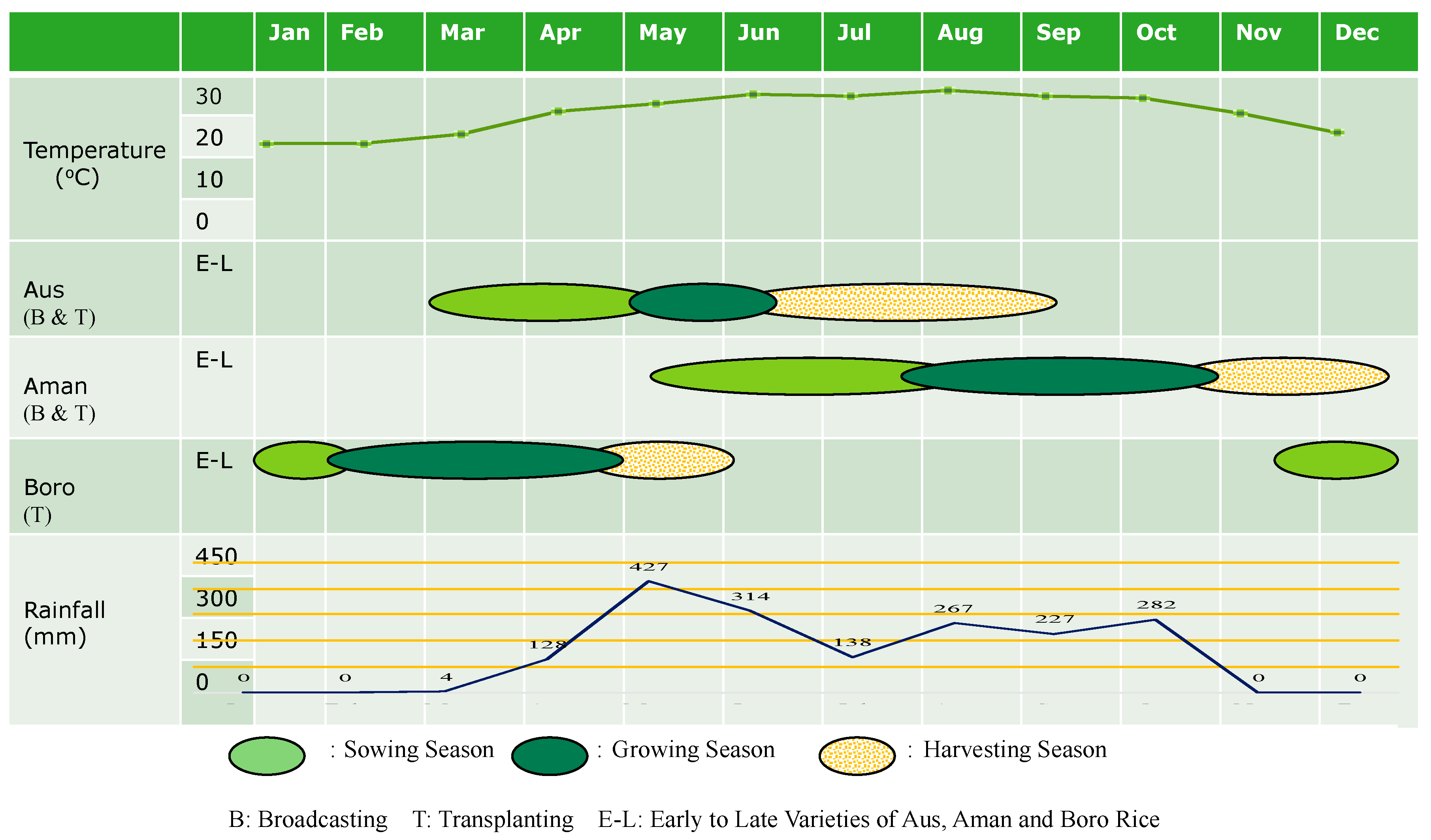
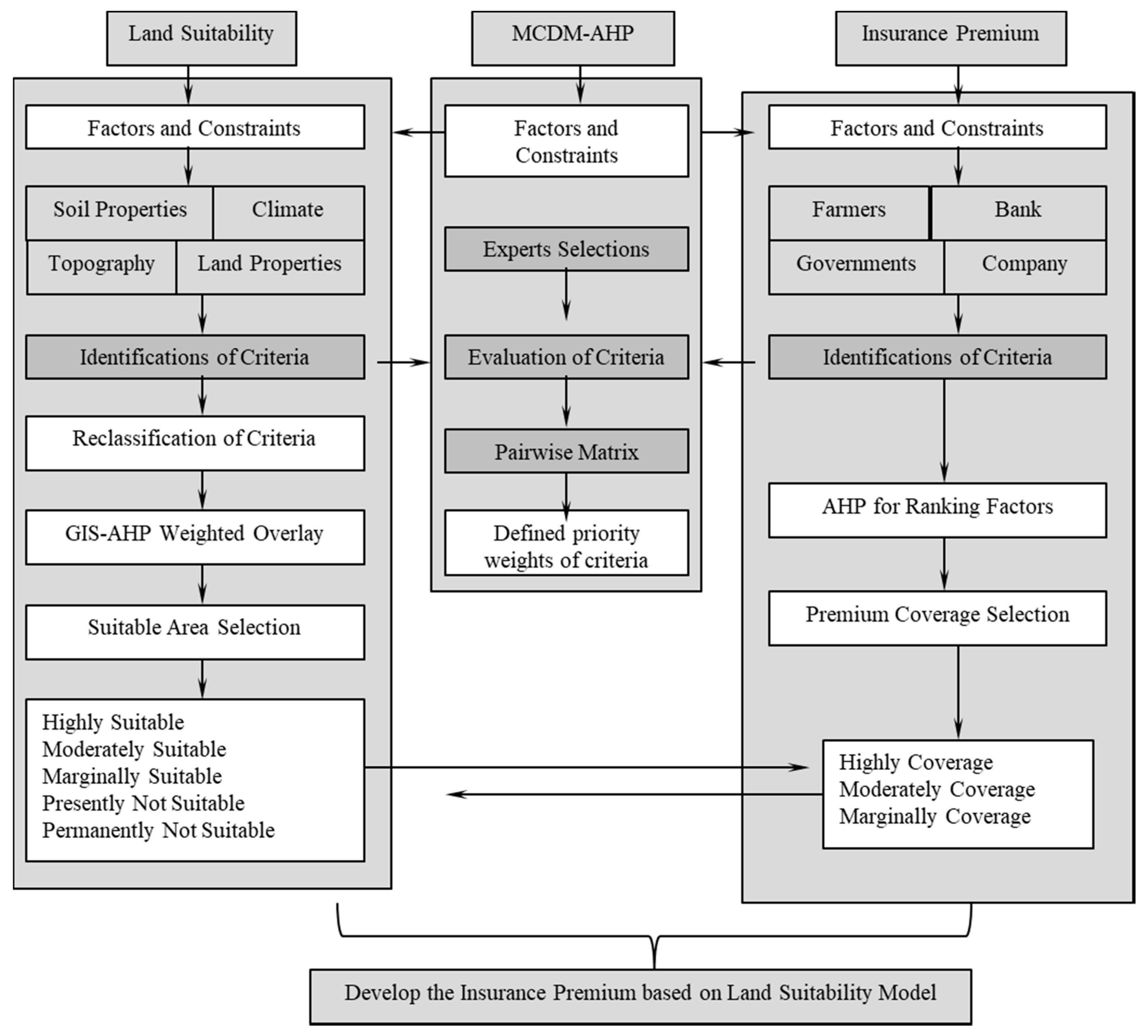
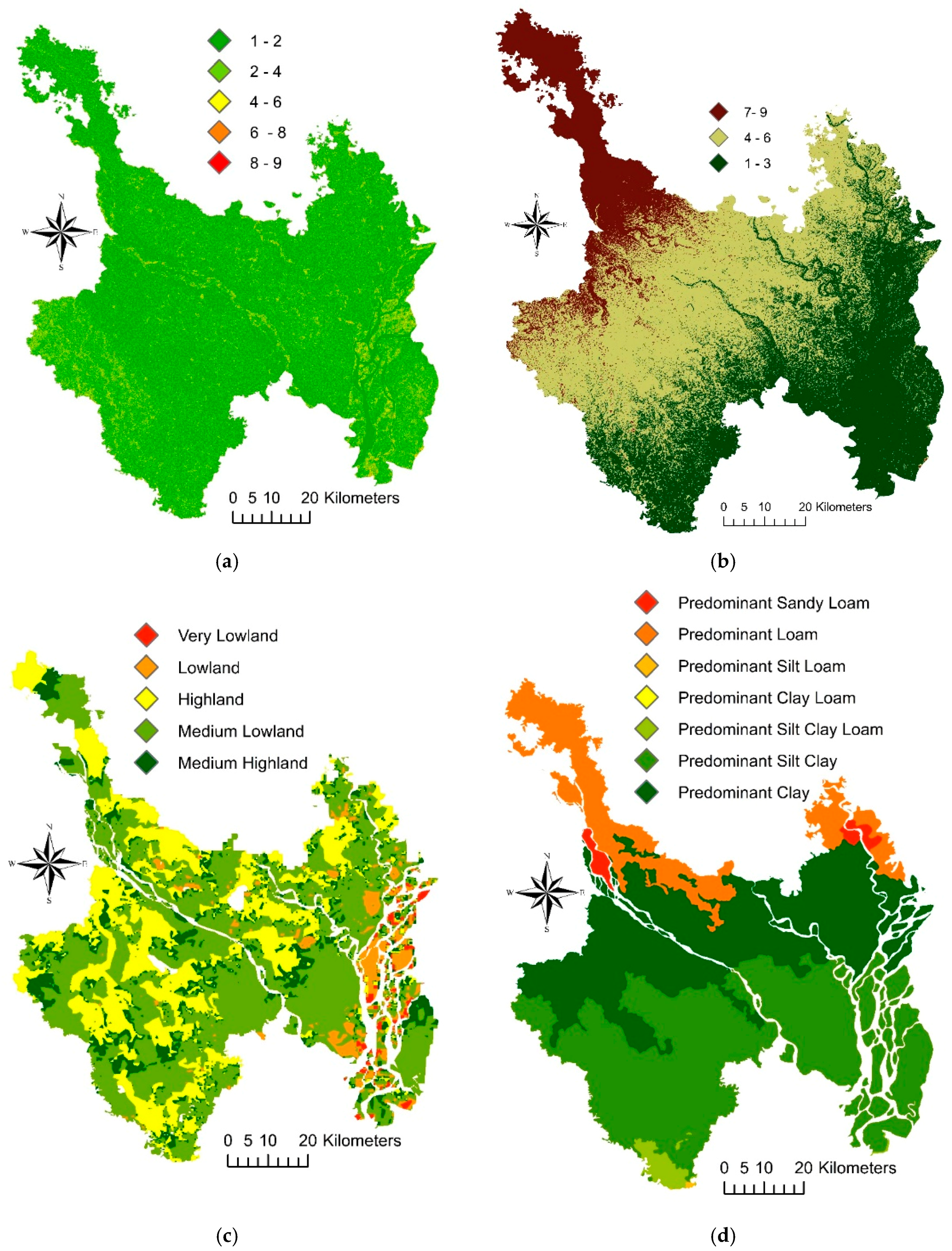
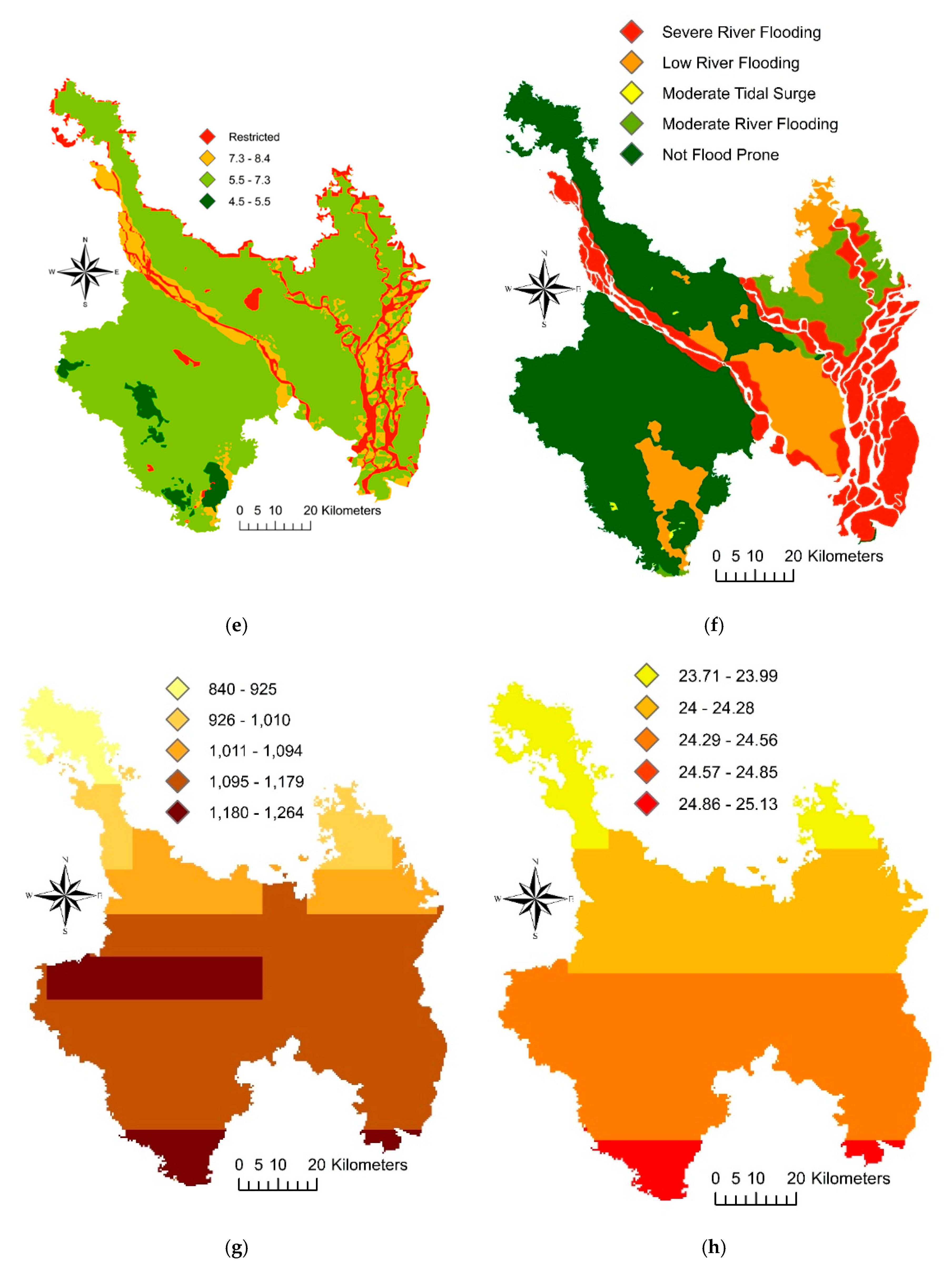
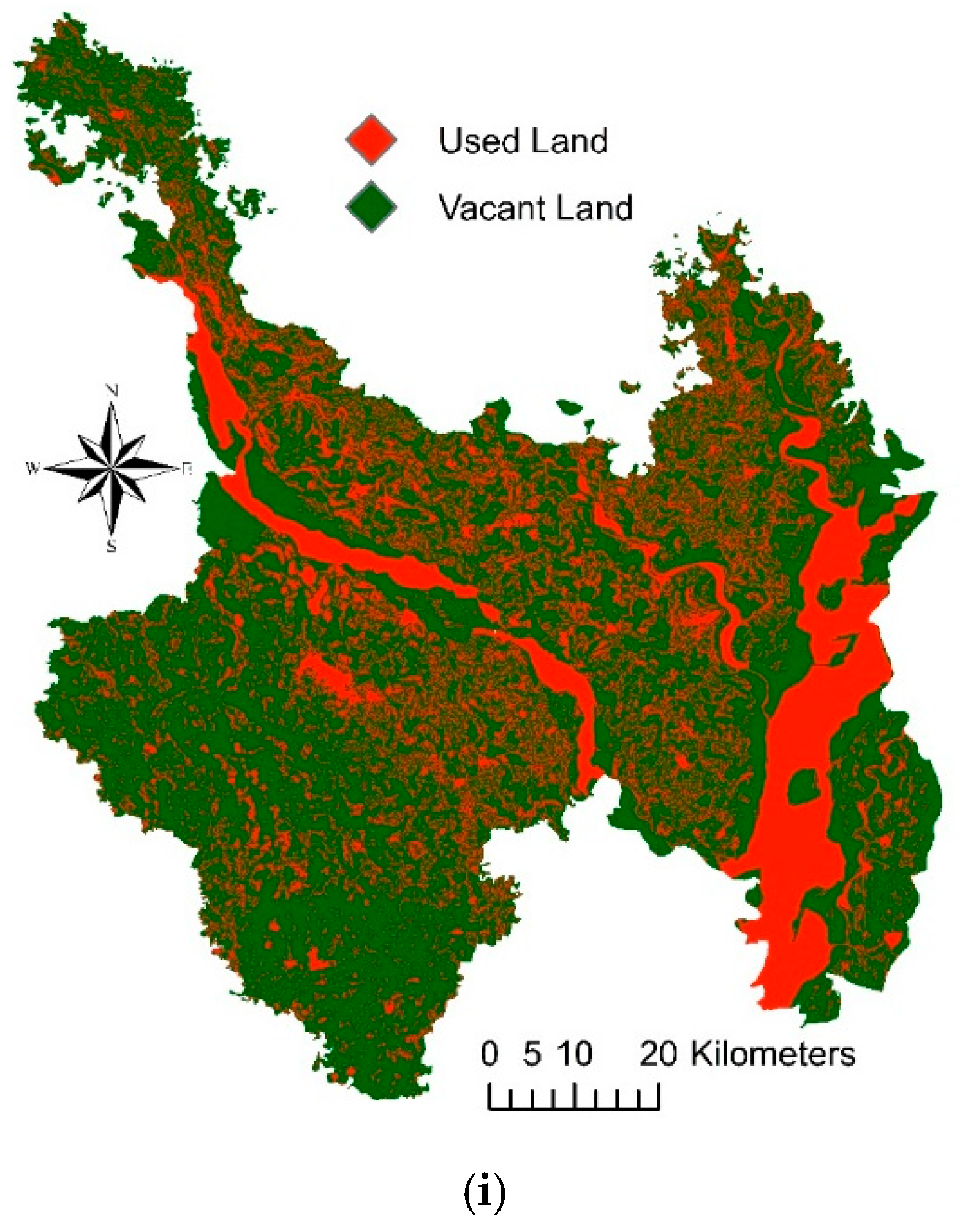
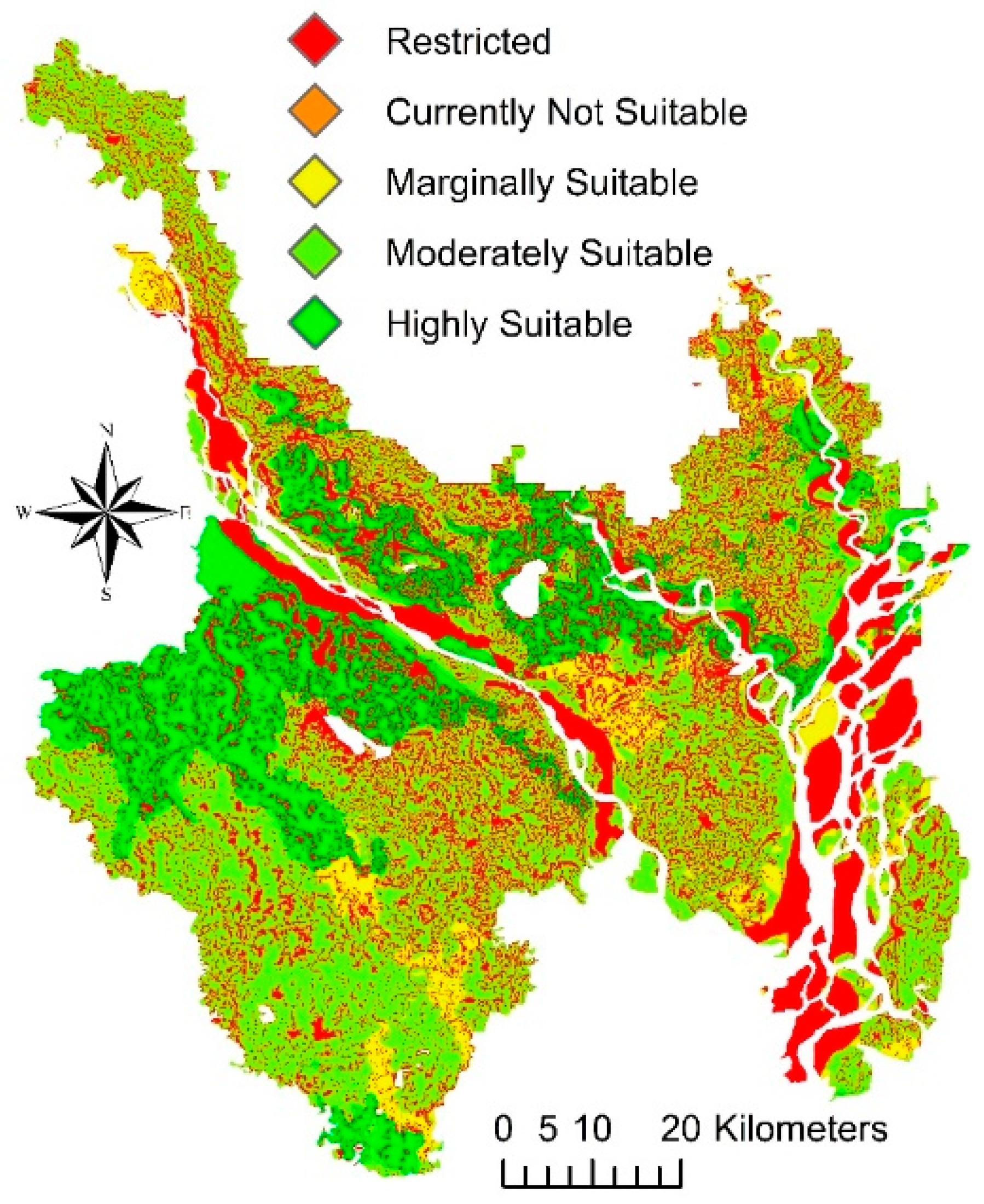
| Criteria | S1 | S2 | S3 | N1 | Reference |
|---|---|---|---|---|---|
| Slope | <10° | 11°–30° | 31°–50° | Atalay, 2006 | |
| Elevation | <50 m | 51–100 m | 101–150 m | 151–200 m | GRiSP, 2013; Walayat et al., 2012 |
| Land Type | Medium High/lowland | High Land | Lowland | Very Lowland | Paul and Rashid, 2016; BBS, 2016 |
| Top Soil Texture | Predominant Clay Predominant Silt Clay Predominant Silt Clay Loam | Predominant Silt Loam Predominant Clay Loam | Predominant Loam | Predominant Sandy Loam | Dou et al., 2016; USDA; Asai et al., 2009 |
| Soil pH | 5.5–7.3 | 7.3–8.4 | 4.5–5.5 | <4 & >8 | Samanta et al., 2011; Ayehuet al., 2015; Kihoro et al., 2013 |
| Flood Prone | Not Flood Prone | Moderate Tidal Surge | Moderate River Flooding | Low River Flooding, Severe River Flooding | Datta et. al., 2017; BBS, 2016 |
| Temperature | 20–30 | 10–20 | 30–40 | Samanta et al., 2011; Kihoro et al., 2013 | |
| Rainfall | 1000–2000 mm | 2000–3500 mm | More than 3500 mm | GRiSP, 2013 | |
| Land Use | Settlements, Rivers, Waterbodies, Forests | Restrictions | |||
| Textural Classes | Description (USDA) | Rating |
|---|---|---|
| Sands | More than 85% sand, 0%–10% clay, and 0%–15% silt | 3 |
| Loamy Sands | 70%–91% sand, 0%–15% clay, and 0%–30% silt | 3 |
| Sandy Loams | More than 43% sand, less than 7% clay, and less than 50% silt | 3 |
| Sandy Clay Loam | More than 45% sand, 20%–35% clay, less than 28% silt | 3 |
| Sandy Clay | 45% or more sand and 35% or more clay | 2 |
| Loam | Less than 52% sand, 7%–27% clay, 28%–50% silt | 2 |
| Silt Loam | Less than 12% clay and 50%–80% silt | 2 |
| Clay Loam | 20%–45% sand and 27%–40% clay | 2 |
| Silt | Less than 12% clay and 80% or more silt | 2 |
| Silty Clay Loam | Less than 20% sand and 27%–40% clay | 1 |
| Silty Clay | 40% or more clay and 40% or more silt | 1 |
| Clay | Less than 45% sand, 40% or more clay, and less than 40% silt | 1 |
| Intensity of Importance | Explanation |
|---|---|
| 1 | Equally important |
| 3 | Moderately important to one activity over another |
| 5 | Strongly important to one activity over another |
| 7 | Very strong important to one activity over another |
| 9 | Extremely important to one activity over another |
| 2, 4, 6, 8 | When compromise is needed Intermediate values |
| Reciprocals | Values for inverse comparison |
| Factors | A | B | C | D | E | F | G | H | I | J | Average |
|---|---|---|---|---|---|---|---|---|---|---|---|
| Slope | 0.110 | 0.022 | 0.091 | 0.127 | 0.039 | 0.065 | 0.069 | 0.033 | 0.126 | 0.037 | 0.072 |
| Elevation | 0.175 | 0.040 | 0.052 | 0.179 | 0.041 | 0.049 | 0.050 | 0.038 | 0.053 | 0.038 | 0.071 |
| Land type | 0.147 | 0.399 | 0.278 | 0.127 | 0.084 | 0.281 | 0.215 | 0.268 | 0.221 | 0.306 | 0.233 |
| Top Soil Texture | 0.108 | 0.037 | 0.259 | 0.127 | 0.040 | 0.065 | 0.116 | 0.070 | 0.192 | 0.077 | 0.109 |
| Soil pH | 0.053 | 0.029 | 0.023 | 0.055 | 0.062 | 0.034 | 0.021 | 0.035 | 0.039 | 0.039 | 0.039 |
| Flood Prone | 0.103 | 0.092 | 0.028 | 0.133 | 0.073 | 0.094 | 0.084 | 0.096 | 0.045 | 0.103 | 0.085 |
| Temperature | 0.130 | 0.234 | 0.131 | 0.107 | 0.358 | 0.221 | 0.138 | 0.308 | 0.076 | 0.188 | 0.189 |
| Rainfall | 0.173 | 0.148 | 0.139 | 0.145 | 0.303 | 0.191 | 0.306 | 0.152 | 0.246 | 0.212 | 0.202 |
| CR | 0.086 | 0.096 | 0.098 | 0.035 | 0.094 | 0.090 | 0.096 | 0.055 | 0.097 | 0.072 |
| n | 1 | 2 | 3 | 4 | 5 | 6 | 7 | 8 | 9 | 10 |
|---|---|---|---|---|---|---|---|---|---|---|
| Random consistency index (RI) | 0 | 0 | 0.58 | 0.9 | 1.12 | 1.24 | 1.32 | 1.41 | 1.45 | 1.49 |
| No | Data | Description | Source |
|---|---|---|---|
| 1 | Land Use Map | Scale at 1:50,000 | 2015, LGED, Bangladesh |
| 2 | Slope Map | Derived from 30-m resolution | 2017, DEM STRM |
| 3 | Elevation Map | Derived from 30-m resolution | 2017, DEM STRM |
| 4 | Land type | Scale 1:50,000 | 2015, BCA, Bangladesh |
| 5 | Top Soil Texture Map | Scale 1:50,000 | 2015, BCA, Bangladesh |
| 6 | Soil pH Map | Scale 1:50,000 | 2015, BCA, Bangladesh |
| 7 | Flood Prone Map | Scale 1:50,000 | 2015, BCA, Bangladesh |
| 8 | Temperature Map | Scale 1:50,000 | 2015, BCA, Bangladesh |
| 9 | Rainfall Map | Scale 1:50,000 | 2015, BCA, Bangladesh |
| Factors | A | B | C | D | E | F | G | H | I | J | Average |
|---|---|---|---|---|---|---|---|---|---|---|---|
| Product Price | 0.268 | 0.341 | 0.278 | 0.279 | 0.084 | 0.281 | 0.215 | 0.399 | 0.221 | 0.306 | 0.267 |
| Government Subsidy | 0.070 | 0.223 | 0.259 | 0.112 | 0.040 | 0.065 | 0.116 | 0.037 | 0.192 | 0.077 | 0.119 |
| Awareness | 0.033 | 0.165 | 0.091 | 0.065 | 0.039 | 0.065 | 0.069 | 0.022 | 0.126 | 0.037 | 0.071 |
| Willingness of the Government | 0.035 | 0.022 | 0.023 | 0.029 | 0.062 | 0.034 | 0.021 | 0.029 | 0.039 | 0.039 | 0.033 |
| Believe of Benefits | 0.038 | 0.049 | 0.052 | 0.065 | 0.041 | 0.049 | 0.050 | 0.040 | 0.053 | 0.038 | 0.048 |
| Trust to the Company | 0.096 | 0.027 | 0.028 | 0.028 | 0.073 | 0.094 | 0.084 | 0.092 | 0.045 | 0.103 | 0.067 |
| Rules and Regulations | 0.152 | 0.091 | 0.139 | 0.239 | 0.303 | 0.191 | 0.306 | 0.148 | 0.246 | 0.212 | 0.203 |
| Collection and Distribution of money | 0.308 | 0.082 | 0.131 | 0.183 | 0.358 | 0.221 | 0.138 | 0.234 | 0.076 | 0.188 | 0.192 |
| CR | 0.055 | 0.097 | 0.098 | 0.097 | 0.094 | 0.090 | 0.096 | 0.096 | 0.097 | 0.072 |
| Classes | Area (sq. km) | % |
|---|---|---|
| Highly Suitable | 1337.02 | 22.74 |
| Moderately Suitable | 1678.04 | 28.54 |
| Marginally Suitable | 873.71 | 14.86 |
| Currently Not Suitable | 69.97 | 1.19 |
| Permanently Not Suitable | 1920.87 | 32.67 |
| Total | 5879.60 | 100 |
| Marginally Coverage (70% Yield Coverage) | Moderately Coverage (80% Yield Coverage) | Highly Coverage (90% Yield Coverage) | |||||||
|---|---|---|---|---|---|---|---|---|---|
| Percent-Age (%) | Per Hector (USD) | Per Pixel (USD) | Percent-Age (%) | Per Hector (USD) | Per Pixel (USD) | Percent-Age (%) | Per Hector (USD) | Per Pixel (USD) | |
| Highly Suitable | 2% | 238.98 | 8.07 | 3% | 271.87 | 9.18 | 4% | 304.45 | 10.28 |
| Moderately Suitable | 3% | 237.89 | 8.03 | 4% | 270.62 | 9.13 | 5% | 303.05 | 10.23 |
| Marginally Suitable | 4% | 236.80 | 8.00 | 5% | 269.38 | 9.09 | 6% | 301.66 | 10.18 |
© 2018 by the authors. Licensee MDPI, Basel, Switzerland. This article is an open access article distributed under the terms and conditions of the Creative Commons Attribution (CC BY) license (http://creativecommons.org/licenses/by/4.0/).
Share and Cite
Islam, M.M.; Ahamed, T.; Noguchi, R. Land Suitability and Insurance Premiums: A GIS-based Multicriteria Analysis Approach for Sustainable Rice Production. Sustainability 2018, 10, 1759. https://doi.org/10.3390/su10061759
Islam MM, Ahamed T, Noguchi R. Land Suitability and Insurance Premiums: A GIS-based Multicriteria Analysis Approach for Sustainable Rice Production. Sustainability. 2018; 10(6):1759. https://doi.org/10.3390/su10061759
Chicago/Turabian StyleIslam, Md Monjurul, Tofael Ahamed, and Ryozo Noguchi. 2018. "Land Suitability and Insurance Premiums: A GIS-based Multicriteria Analysis Approach for Sustainable Rice Production" Sustainability 10, no. 6: 1759. https://doi.org/10.3390/su10061759
APA StyleIslam, M. M., Ahamed, T., & Noguchi, R. (2018). Land Suitability and Insurance Premiums: A GIS-based Multicriteria Analysis Approach for Sustainable Rice Production. Sustainability, 10(6), 1759. https://doi.org/10.3390/su10061759







